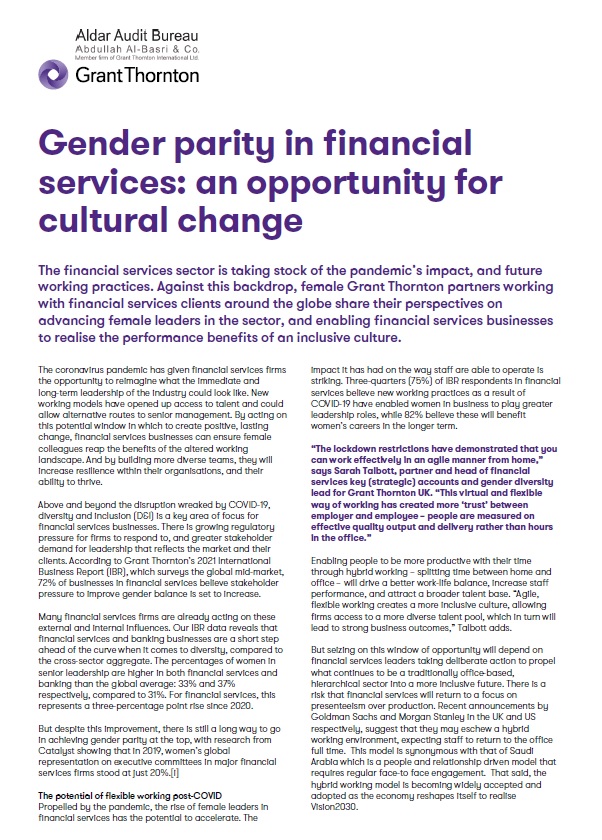-
IFRS
At Grant Thornton, our IFRS advisers can help you navigate the complexity of financial reporting.
-
Audit quality monitoring
Having a robust process of quality control is one of the most effective ways to guarantee we deliver high-quality services to our clients.
-
Global audit technology
We apply our global audit methodology through an integrated set of software tools known as the Voyager suite.
-
Supply Chain and Operation Services
An optimised and resilient supply chain is essential for success in an ever-evolving business landscape
-
Business risk services
The relationship between a company and its auditor has changed. Organisations must understand and manage risk and seek an appropriate balance between risk and opportunities.
-
Marketing and Client Service
We offer strategy, client service, digital and insight solutions to businesses that are shaping the future across the Middle East.
-
Forensic services
At Grant Thornton, we have a wealth of knowledge in forensic services and can support you with issues such as dispute resolution, fraud and insurance claims.
-
Deal Advisory
At Grant Thornton, we deliver deal advisory services through a strategic lens, providing end-to-end support that enables our clients to unlock value, manage risk, and make informed decisions with confidence. Our team works closely with businesses across Saudi Arabia to navigate the complexities of transactions and drive smart, sustainable outcomes.
-
Growth services
We have designed and developed growth services to support your business at each phase of its growth. So whether you are an SME that has just set up or a large business wishing to expand, at Grant Thornton we will help you unlock your potential for growth.


Above and beyond the disruption wreaked by COVID-19, diversity and inclusion (D&I) is a key area of focus for financial services businesses. There is growing regulatory pressure for firms to respond to, and greater stakeholder demand for leadership that reflects the market and their clients.
According to Grant Thornton’s 2021 International Business Report (IBR), which surveys the global mid-market, 72% of businesses in financial services believe stakeholder pressure to improve gender balance is set to increase.
Many financial services firms are already acting on these external and internal influences. Our IBR data reveals that financial services and banking businesses are a short step ahead of the curve when it comes to diversity, compared to the cross-sector aggregate. The percentages of women in senior leadership are higher in both financial services and banking than the global average: 33% and 37%
respectively, compared to 31%. For financial services, this represents a three-percentage point rise since 2020.
But despite this improvement, there is still a long way to go in achieving gender parity at the top, with research from Catalyst showing that in 2019, women’s global representation on executive committees in major financial services firms stood at just 20%.[i]
Three-quarters (75%) of IBR respondents in financial services believe new working practices as a result of COVID-19 have enabled women in business to play greater leadership roles, while 82% believe these will benefit women’s careers in the longer term.
“The lockdown restrictions have demonstrated that you can work effectively in an agile manner from home,” says Sarah Talbott, partner and head of financial services key (strategic) accounts and gender diversity lead for Grant Thornton UK. “This virtual and flexible way of working has created more ‘trust’ between employer and employee – people are measured on effective quality output and delivery rather than hours in the office.”
Enabling people to be more productive with their time through hybrid working – splitting time between home and offce – will drive a better work-life balance, increase staff performance, and attract a broader talent base. “Agile, flexible working creates a more inclusive culture, allowing firms access to a more diverse talent pool, which in turn will lead to strong business outcomes,” Talbott adds.
But seizing on this window of opportunity will depend on financial services leaders taking deliberate action to propel what continues to be a traditionally offce-based, hierarchical sector into a more inclusive future. There is a risk that financial services will return to a focus on presenteeism over production. Recent announcements by Goldman Sachs and Morgan Stanley in the UK and US respectively, suggest that they may eschew a hybrid working environment, expecting staff to return to the office full time. This model is synonymous with that of Saudi Arabia which is a people and relationship driven model that requires regular face-to face engagement. That said, the hybrid working model is becoming widely accepted and adopted as the economy reshapes itself to realise Vision2030.
The inclusive culture challenge
Failure to fully appreciate the correlation between inclusivity and performance was also apparent among financial services firms in the height of lockdown. Grant Thornton’s research reveals that financial services firms were slow to act on engagement during the pandemic, and are weaker at creating an inclusive culture than other industries. Only 32% of financial services respondents instituted new working practices to better engage all employees, compared to 37% across all sectors.
Similarly, at 36%, financial services businesses were nine percentage points behind the global score in promoting work-life balance and flexibility. The seeming contradiction between the relatively encouraging numbers of women in senior management and the belief that flexible working benefits women’s careers within the sector, and its sluggish progress on inclusion may reflect the work of quantitative diversity policies and quotas around gender balance, versus an established
organisational culture that has yet to evolve.
To change this state of affairs, cultural tone must be set by those at the top, and cascade throughout the business. “The issue of gender diversity and female leadership is not just a women’s problem, it is a business issue, and until such time as senior males are on board with representation and diversity at all levels, we’re not going to get there,” says Madeleine Mattera, national head of financial services, Grant Thornton Australia. So should quotas and D&I metrics be abandoned in favour of organisational transformation?
“For females to be strategically represented in leadership positions across financial services in Saudi Arabia, the balance must be addressed in order to drive inclusive governance which drives value across the industry and wider economy. Stakeholder pressure coupled with mandatory requirements will act as levers to drive change, however this will not be sufficient to drive the industry cultural change which is required”, said Imad Adileh, Principal of Saudi Arabia Grant Thornton.
